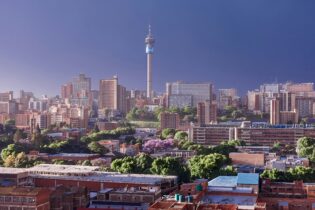A public and private sector partnership with strong community involvement and buy-in was seen as a way to facilitate a better balance between social responsibility and financial sustainability for the long-term success of the housing development. At the time of its proposal more than a decade ago, the Cosmo City housing development was seen as a pioneering prototype for the post-1994 challenges to redress urban spatial inefficiencies in South Africa.
This was to be achieved through an overhaul in the country’s legislative and policy framework for land-use planning. The project was seen as a benchmark for a new model of low-cost housing that aimed to create integrated and mixed land use closer to urban and transport centres, rather than on the metropolitan edges, which effectively reinforces marginalisation and poverty. In 1996, the Northern Metropolitan Local Council (now the City of Johannesburg), in the preparation of its Land Development Objectives, identified the need to provide housing for two large informal communities, Zevenfontein and Riverbend. These informal settlements were characterised by substandard living conditions with limited access to basic services. Mixed-use planningThe idea was to relocate the communities onto land that would be earmarked on the basis of access to economic opportunities and public transport in a mixed-income and mixed-use development.
A public and private sector partnership with strong community involvement and buy-in was seen as a way to facilitate a better balance between social responsibility and financial sustainability for the long-term success of the housing development. After identifying land for public use, the City of Johannesburg had to use existing legislation to appropriate the 1 200 ha on which Cosmo City would be built. A protracted period of legal and consultative processes preceded the eventual development framework and technical studies for the project. By 2000, the now City of Johannesburg and the Gauteng Department of Housing had invited tenders for development proposals for Cosmo City, with its location being northwest of Randburg. A team headed by Basil Read and Kopana Ke Matla was the successful bidder, and together these formed a company called Codevco. They then brought in the expertise of professional teams, including consulting engineers KV3, now known as WorleyParsons. The final go-ahead for the project was given in October 2004 and the pegging of the first phase began in November of the same year. Construction of the infrastructure and services started in January 2005 and the first beneficiaries took occupation of their homes in November 2005. Integrating housing typologies
One of the key objectives at the time of planning the Cosmo City project was to bring together people of different income groups that would be living in the same area. The intention was to achieve this through the provision of different housing tenure and price types in the same area, linked through schools, crèches, clinics, transport, parks and public spaces.
“The integrated approach means bringing different housing typologies in one area together, yet creating some demarcation with the use, for example, of streams or natural wetland areas so that the respective property values remain intact,” says Marius Kannenberg, technical director at WorleyParsons. The Cosmo City development was therefore apportioned according to house values comprising a split among 4 992 fully subsidised houses, 2 959 finance/credit-linked units ranging from R180 000 to R280 000 and 3 337 bonded houses in the R380 000 to R800 000 price range. Breaking new ground
As the first development of its kind and scale in South Africa, Cosmo City has become a point of reference for the kind of public housing envisioned under the government’s Breaking New Ground programme, in which the emphasis has evolved to assert the idea of subsidised homes as assets, with title deeds assisting in the development of the secondary market. The Department of Housing’s 1997 Urban Development Framework sets out the government’s mandate to develop environmentally sustainable urban settlements in conjunction with a regulatory and environmental policy that enables the most efficient trade-off between building affordable and quality housing and using renewable and non-renewable resources to balance consumption needs.
Sustainable strategies
In line with the broader vision contained in South Africa’s National Sustainable Development Strategy, the Urban Development Framework looks at the sustainable use of resources and the protection of ecologically sensitive areas as a focal point for future urban development.
• an ecological management plan for the conservation areas
• environmental management plans for construction and operational activities on site
• an environmental impact assessment report (focusing on heritage, geology, soil, hydrology and storm water attenuation)
• a biodiversity report. Cosmo City environment management
Once these had been completed and construction started, all building activities on the site had to be strictly monitored by a full-time environmental control officer, prescribed in the environmental management plan and approved by the Gauteng Department of Agriculture, Culture and the Environment (GDACE). According to Kannenberg, ahead of the construction work nearly 21 000 protected and medicinal plants were transplanted to the Suikerbosch Rand Nature Reserve and the indigenous vegetation on the Cosmo City site was preserved in a 300 ha conservation park, protected by a 42 km palisade fence. While it was inevitable that large tracts of natural vegetation would be lost in the development process, this was compensated for by planting trees and shrubs throughout. “The fact that the terrain was sandy was a challenge because of erosion. However, the grassing of municipal parks by the city council and the establishment of gardens throughout Cosmo City reduced the impact of this dramatically.” Basil Read Developments established a pilot nursery at Cosmo City and trained staff to propagate trees and shrubs as part of its Green Projects programme. Using the latest innovative technology, the nursery conducts ongoing research on, for example, the use of microorganisms and earthworm farming to help create and maintain sustainable ecosystems. There is also continual cross-linking between these kinds of private programmes and municipal schemes aimed at making Cosmo City an environmentally cohesive development. For example, the City of Johannesburg, in its Climate Proofing of Urban Communities Project, installed 700 low-pressure solar water heater (SWH) units, distributed compact fluorescent lamps and fitted insulated IsoBoard ceilings in all the subsidised houses. This follows the first phase of installation of 170 SWHs in 2007 as part of the Department of Energy’s target for the provision of one million SWH units throughout the country within five years. The low-cost units have also all been fitted with prepaid water and electricity metres.







